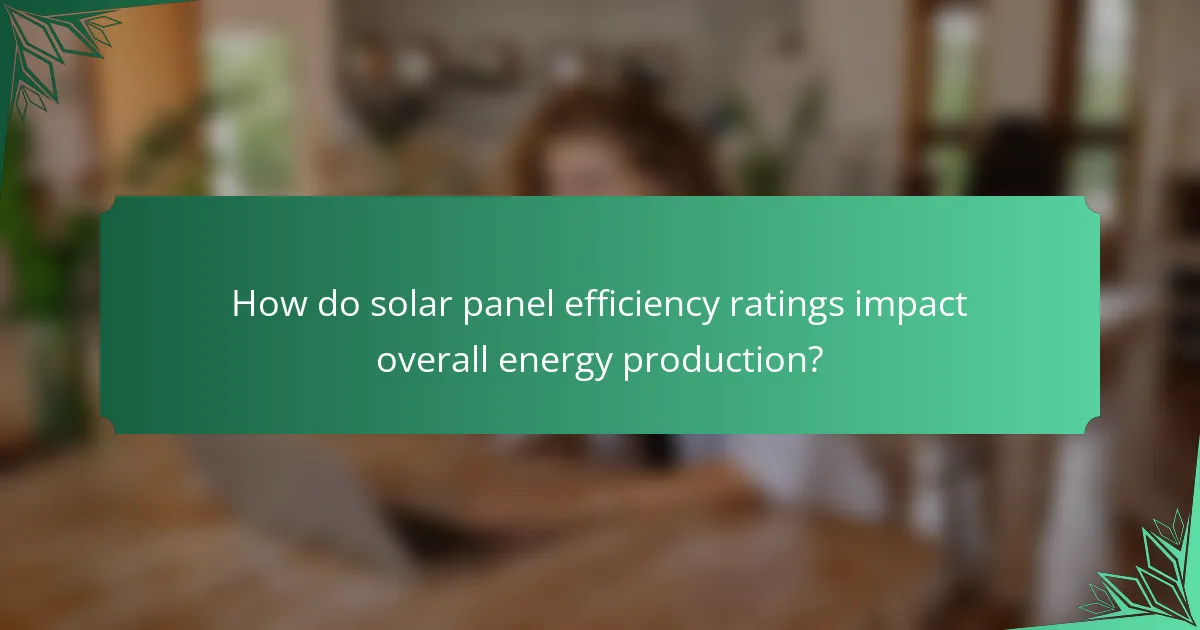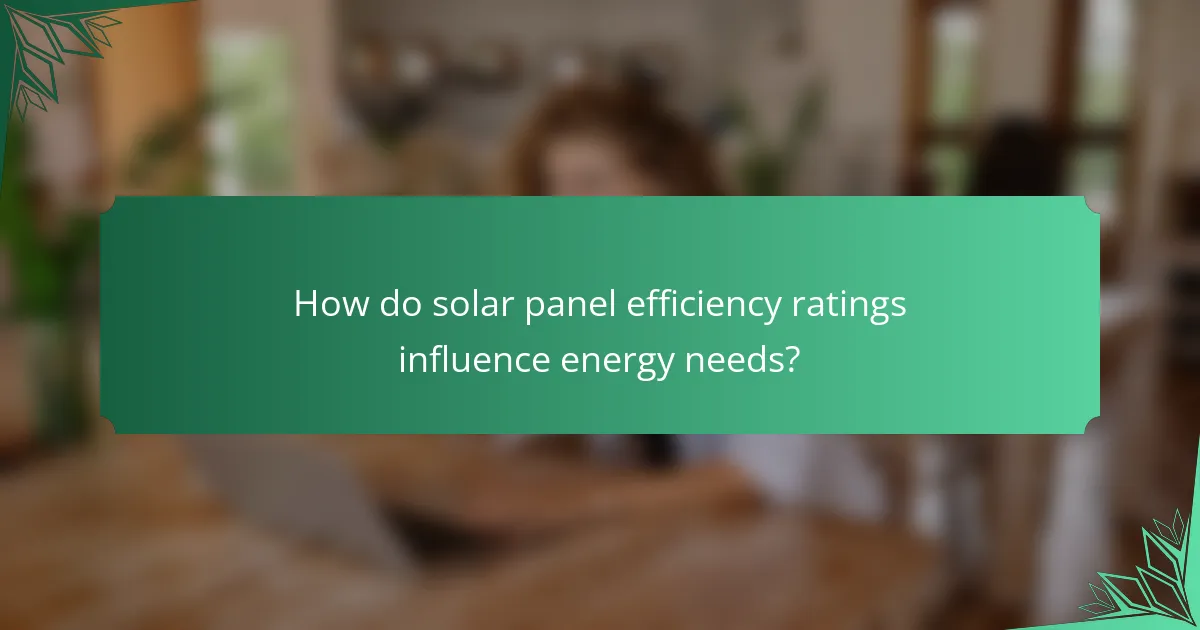
How do solar panel efficiency ratings impact overall energy production?
Solar panel efficiency ratings directly influence overall energy production. Higher efficiency ratings mean that a greater percentage of sunlight is converted into usable electricity. For example, a solar panel with a 20% efficiency rating converts 20% of sunlight into energy, while a 15% efficiency panel only converts 15%. This difference impacts the total energy output from a solar installation.
Higher efficiency panels require less space to produce the same amount of energy as lower efficiency panels. Therefore, in areas with limited roof space, higher efficiency panels are essential for maximizing energy production. Additionally, efficiency ratings affect the overall system design and sizing. Systems with higher efficiency can meet energy needs more effectively, potentially reducing the number of panels required.
In terms of grid connection, higher efficiency ratings can lead to better integration into the energy grid. This is because they can produce more energy in less space, making them suitable for urban environments. Overall, solar panel efficiency ratings are crucial for optimizing energy production and determining the feasibility of solar installations in various settings.
What factors contribute to solar panel efficiency ratings?
Solar panel efficiency ratings are influenced by several key factors. These factors include the type of solar cells used, which determine how effectively sunlight is converted into electricity. Monocrystalline panels typically offer higher efficiency compared to polycrystalline options.
Temperature also plays a significant role; higher temperatures can reduce efficiency. The angle and orientation of the panels affect sunlight exposure, impacting their overall performance.
Additionally, shading from nearby structures or trees can lower efficiency ratings. The quality of materials and manufacturing processes contributes to the durability and performance of solar panels.
Finally, advancements in technology continuously improve efficiency ratings over time. For instance, bifacial solar panels can capture sunlight on both sides, enhancing energy output.
How is solar panel efficiency measured?
Solar panel efficiency is measured by the ratio of the electrical output of a solar panel to the solar energy input it receives. This ratio is expressed as a percentage. The measurement typically occurs under standard test conditions (STC), which include a specific temperature, light intensity, and air mass. The standard conditions are 25 degrees Celsius, 1000 watts per square meter of solar irradiance, and an air mass of 1.5.
To calculate efficiency, the formula used is: Efficiency = (Output Power / Input Power) x 100. For example, if a solar panel produces 300 watts of power under STC and receives 1000 watts of solar energy, the efficiency would be 30%. This measurement allows consumers and manufacturers to compare the performance of different solar panels. Higher efficiency ratings indicate that a panel converts more sunlight into usable electricity.
What are the typical efficiency ratings for different solar panel types?
Monocrystalline solar panels typically have efficiency ratings between 15% and 22%. These panels are known for their high efficiency due to their single-crystal structure. Polycrystalline solar panels generally have lower efficiency ratings, ranging from 13% to 16%. This is attributed to their multi-crystal composition. Thin-film solar panels have the lowest efficiency ratings, usually between 10% and 12%. Their lightweight and flexible design allows for various applications, despite lower efficiency. These efficiency ratings are crucial for determining system sizing and energy needs in solar installations.
Why are efficiency ratings important for system sizing?
Efficiency ratings are important for system sizing because they determine how effectively solar panels convert sunlight into electricity. Higher efficiency ratings mean that fewer panels are needed to meet energy demands. This leads to reduced space requirements for installation. It also impacts the overall cost of the solar system. For instance, a panel with a 20% efficiency rating produces more energy per square meter than one with a 15% rating. Consequently, accurate efficiency ratings help in estimating the size of the solar array needed. They also influence the balance of system components, such as inverters and batteries. Ultimately, efficiency ratings ensure that the solar system is both cost-effective and capable of meeting energy needs.
How do efficiency ratings affect the number of panels needed?
Efficiency ratings directly influence the number of solar panels required for a system. Higher efficiency ratings mean that each panel converts more sunlight into electricity. For example, a panel with a 20% efficiency rating produces more energy than one with a 15% rating. Consequently, fewer high-efficiency panels are needed to meet the same energy demand.
If a home requires 10,000 kWh annually, a 300-watt panel at 20% efficiency generates more energy than a 250-watt panel at 15% efficiency. Therefore, to achieve the same energy output, a homeowner would need approximately 33 panels of 300 watts at 20% efficiency versus 40 panels of 250 watts at 15% efficiency.
This relationship illustrates how efficiency ratings affect system sizing and overall installation costs. Higher efficiency can lead to reduced space requirements and lower labor costs.
What is the relationship between efficiency ratings and available roof space?
Efficiency ratings of solar panels indicate how effectively they convert sunlight into electricity. Higher efficiency ratings mean that more energy can be generated from a smaller area. This relationship is crucial when considering available roof space for installation. Limited roof space necessitates the use of higher efficiency panels to meet energy needs. For example, a panel with a 20% efficiency rating generates more power in a given area than one with a 15% rating. Thus, optimizing available roof space often relies on selecting panels with higher efficiency ratings to maximize energy output.

How do solar panel efficiency ratings influence energy needs?
Solar panel efficiency ratings directly influence energy needs by determining how much energy can be generated from a given area. Higher efficiency ratings mean more electricity is produced per square meter of solar panels. This allows for smaller installations to meet the same energy demands. For example, a solar panel with a 20% efficiency will produce more energy than one with 15% efficiency under the same conditions. Consequently, homeowners may require fewer panels to achieve their desired energy output. This affects system sizing and can reduce costs associated with installation and materials. Additionally, proper sizing based on efficiency ratings ensures that energy needs are met without oversizing the system, leading to optimal energy management.
What role do efficiency ratings play in calculating energy consumption?
Efficiency ratings indicate how effectively a solar panel converts sunlight into usable energy. These ratings directly impact the amount of energy produced by a solar system. Higher efficiency ratings mean more energy output for the same amount of sunlight. This results in a smaller number of panels needed to meet energy needs. Consequently, this affects system sizing and installation costs. For example, a panel with a 20% efficiency rating generates more energy than one with a 15% rating under identical conditions. Accurate calculations of energy consumption depend on these ratings to ensure optimal energy production and grid connection compatibility.
How can homeowners estimate their energy needs based on panel efficiency?
Homeowners can estimate their energy needs based on panel efficiency by calculating their average energy consumption and matching it with the output of solar panels. First, they should review their electricity bills to determine monthly usage in kilowatt-hours (kWh). Next, they need to consider the efficiency rating of the solar panels they plan to install, which typically ranges from 15% to 22%.
To estimate the energy production, homeowners can use the formula: (Panel Efficiency) x (Sunlight Hours) x (Panel Area) = Energy Output. For example, a panel rated at 20% efficiency with 5 sunlight hours daily and a 1.6 m² area would produce approximately 1.6 kWh daily.
By comparing this output with their monthly consumption, homeowners can gauge the number of panels required. For instance, if a home uses 900 kWh monthly, they would need enough panels to generate about 30 kWh daily. This calculation helps homeowners size their solar system effectively.
What tools are available for assessing energy needs with efficiency ratings?
Energy modeling software and online calculators are available for assessing energy needs with efficiency ratings. Tools like HOMER, PVWatts, and EnergyPlus provide detailed analyses of energy consumption and solar panel efficiency. These tools allow users to input various parameters, including location, energy usage patterns, and system specifications. They generate efficiency ratings based on the performance of solar panels under specific conditions. Additionally, the U.S. Department of Energy offers resources to help estimate energy needs and evaluate efficiency. These tools are widely used in the industry for accurate energy assessments and system sizing.
How can improved efficiency ratings lead to cost savings?
Improved efficiency ratings in solar panels lead to cost savings by maximizing energy output per square foot. Higher efficiency means more electricity generated from the same amount of sunlight. This reduces the number of panels needed for a specific energy requirement. Fewer panels lower installation and material costs. Additionally, less space is required for installation, which can be a significant factor in urban areas. According to the National Renewable Energy Laboratory, increasing panel efficiency can reduce the overall system cost by up to 20%. Enhanced efficiency also leads to lower long-term energy costs due to increased energy production. Overall, improved efficiency ratings directly correlate with reduced financial investment in solar energy systems.
What are the long-term financial benefits of higher efficiency panels?
Higher efficiency solar panels provide significant long-term financial benefits. They generate more electricity per square foot compared to lower efficiency panels. This leads to reduced energy costs over time. Higher efficiency panels also require fewer units to achieve the same energy output. This can lower installation costs and space requirements. Additionally, they often come with longer warranties, providing peace of mind against future repairs. According to the U.S. Department of Energy, higher efficiency panels can yield a return on investment that is 20% higher than standard panels over their lifespan. This is due to increased energy production and potential incentives for using advanced technology. Higher efficiency panels can also enhance property value, making them a smart financial choice.
How do efficiency ratings affect return on investment for solar systems?
Efficiency ratings directly influence the return on investment (ROI) for solar systems. Higher efficiency ratings mean that solar panels convert more sunlight into electricity. This leads to increased energy production from the same amount of space. For example, a panel with a 20% efficiency rating generates more electricity than one with a 15% efficiency rating.
Increased energy production results in lower electricity bills. This savings contributes to a faster payback period. A study by the National Renewable Energy Laboratory shows that higher efficiency systems can provide a 10-20% better ROI.
Additionally, efficient systems may require fewer panels to meet energy needs. This reduces installation costs and space requirements. Thus, higher efficiency ratings enhance overall system performance and financial returns.

How do solar panel efficiency ratings affect grid connection requirements?
Solar panel efficiency ratings directly impact grid connection requirements by determining the amount of energy generated per unit area. Higher efficiency panels produce more electricity for the same surface area compared to lower efficiency options. This affects the overall system size needed to meet energy demands. For instance, a system designed with higher efficiency panels may require fewer panels to achieve the same output, simplifying grid connection logistics. Additionally, local regulations often stipulate specific generation thresholds for grid connection. Higher efficiency ratings can help meet these thresholds more easily. Therefore, selecting efficient solar panels can facilitate smoother integration with the grid and compliance with connection standards.
What are the implications of efficiency ratings on grid compatibility?
Efficiency ratings directly impact grid compatibility by determining how effectively solar panels convert sunlight into usable electricity. Higher efficiency ratings mean that panels produce more energy per square meter. This allows for smaller installations to meet energy needs, facilitating easier integration into existing grids.
When solar panels have higher efficiency, they can generate sufficient power even in limited space. This is particularly beneficial in urban areas where space is constrained. Additionally, high-efficiency panels can reduce the strain on grid infrastructure. They can provide more consistent energy output, which is crucial for maintaining grid stability.
Research indicates that systems with higher efficiency ratings contribute to lower energy losses during transmission. This enhances overall grid performance and reliability. Therefore, efficiency ratings play a critical role in ensuring that solar energy systems are compatible with and beneficial to the electrical grid.
How do efficiency ratings influence net metering policies?
Efficiency ratings directly influence net metering policies by determining how much energy a solar system can produce. Higher efficiency ratings mean that solar panels convert more sunlight into electricity. This increased production can lead to greater credits for excess energy fed back into the grid. Net metering policies often reward users based on the amount of energy they supply to the grid. Therefore, systems with higher efficiency ratings can generate more credits under these policies. For instance, a study by the National Renewable Energy Laboratory found that higher efficiency panels can significantly increase the financial benefits of net metering. Thus, efficiency ratings play a crucial role in shaping the economic viability of solar installations and their integration with the grid.
What should homeowners consider regarding grid connection when selecting panels?
Homeowners should consider the compatibility of solar panels with their local grid when selecting them. This includes understanding the grid’s voltage and frequency requirements. Homeowners must also assess the capacity of the grid to handle additional power input. A grid that cannot accommodate excess energy may limit the benefits of solar panels. Additionally, homeowners should evaluate net metering policies in their area. These policies determine how homeowners are compensated for surplus energy. Finally, homeowners should consider potential grid connection fees. These fees can impact the overall cost-effectiveness of the solar panel installation.
How can solar panel efficiency ratings impact energy storage solutions?
Solar panel efficiency ratings directly influence energy storage solutions by determining how much energy can be generated and stored. Higher efficiency ratings mean more electricity is produced from the same amount of sunlight. This increased energy generation can reduce the size and capacity requirements of energy storage systems. For instance, a solar panel with a 20% efficiency rating produces more usable energy than one with a 15% rating under identical conditions.
Consequently, homeowners or businesses may need smaller batteries, which can lower initial investment costs. The efficiency of solar panels also affects the overall energy balance of the system. Systems with higher efficiency can meet energy needs more effectively, reducing reliance on grid power.
Research indicates that optimizing solar panel efficiency can enhance the performance of energy storage systems, leading to better cost-effectiveness and sustainability.
What is the relationship between panel efficiency and battery storage capacity?
Panel efficiency directly impacts battery storage capacity requirements. Higher efficiency panels convert more sunlight into electricity. This means less solar panel area is needed to generate the same amount of energy. Consequently, with fewer panels, the energy produced can be stored more effectively in batteries.
For example, a solar panel with 20% efficiency produces more energy per square meter than one with 15% efficiency. Therefore, a system with high-efficiency panels may require a smaller battery capacity to meet the same energy needs. This relationship helps optimize space and costs in solar energy systems.
How do efficiency ratings affect the choice of inverter technology?
Efficiency ratings significantly influence the choice of inverter technology. Higher efficiency ratings indicate that an inverter can convert more DC electricity from solar panels into usable AC electricity. This efficiency is critical when matching inverters to high-efficiency solar panels. For example, a solar panel with a 20% efficiency rating requires an inverter that can handle the increased energy output effectively.
Inverters with higher efficiency ratings often come with advanced features, such as better thermal management and optimized energy conversion algorithms. These features enhance overall system performance, especially in varying sunlight conditions. According to the National Renewable Energy Laboratory, inverters with efficiency ratings above 95% can maximize energy harvest from high-efficiency solar panels.
Therefore, selecting inverter technology with a suitable efficiency rating is essential to ensure optimal performance and energy output from the entire solar energy system.
What best practices should homeowners follow when selecting solar panels based on efficiency ratings?
Homeowners should prioritize solar panels with high efficiency ratings for optimal energy output. Selecting panels above 20% efficiency ensures better performance in limited space. Research efficiency ratings from reputable sources like the National Renewable Energy Laboratory. Compare the efficiency ratings of different brands and models. Consider the degradation rate of solar panels, as lower rates indicate better longevity. Evaluate the warranty offered, as it reflects the manufacturer’s confidence in their product. Analyze the energy needs of the household to determine the appropriate panel size. Assess the local climate, as it impacts solar panel performance.
Solar panel efficiency ratings are a critical factor influencing system sizing, energy needs, and grid connection for solar installations. This article explores how higher efficiency ratings enhance energy production by converting more sunlight into usable electricity, allowing for smaller installations and reduced costs. It also examines the key factors contributing to efficiency ratings, how they are measured, and their implications for energy consumption, storage solutions, and grid compatibility. Understanding these dynamics is essential for homeowners and businesses looking to optimize their solar energy systems.